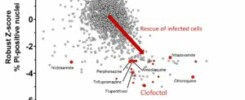On the occasion of the 15th edition of the Rare Diseases awareness campaign which took place on February 28, 2022, we wish to join those who improve the general public’s knowledge of rare diseases.
Apteeus is interested in finding treatment for patients with unmet medical needs. Rare diseases such as mucopolysaccharidosis type II (MPSII) or Hunter syndrome, SMA-PME syndrome or Farber’s disease, Krabbe’s disease or the spectrum of Zeleweger diseases are among the pathologies on which we focus our efforts.
With the support of our partners and patient associations, our goal is to contribute to the search for the appropriate treatment for these pathologies. We are happy to have completed the first step for these four pathologies, which consists of setting up the in-vitro model of the disease. This step is followed by the development of a screening test to measure the effect of all drugs and to select those capable of limiting the impact of the disease. Currently we are setting up the screening test as part of the Krabbe disease project.
The screening results on cells from patients with MPSII have made it possible to pre-select certain drug candidates that require additional testing. This is also the case for the Zelleweger spectrum: the screening has enabled us to identify several drug candidates and our work is currently focused on a pre-selected candidate. Some drugs identified by Apteeus are already being studied in patients with SMA-PME and Farber’s disease. Apteeus remains involved in their monitoring alongside the association and doctors in order to obtain the first elements of effectiveness.

Monday, February 28, the city of Lille lights up in the Rare Disease Day colors which are blue, green and pink.
*Rare diseases in detail*
Between 110 and 130 people in France are affected by mucopolysaccharidosis type II (MPSII) with approximately 6 new cases per year. It is a pathology affecting the function of a lysosomal enzyme whose role is to degrade glycosaminoglycans (GAGs). In the absence of the enzyme iduronate 2-sulfatase (IDS), GAGs accumulate within the lysosomes and disrupt their major cell purification function.
Regarding the syndrome of proximal spinal muscular atrophy with progressive myoclonic epilepsy (or SMA-PME) and Farber’s disease, these are extremely rare genetic diseases caused by mutations in the ASAH1 gene. It is the deficiency of one of the lysosomal enzymes, playing an important role in the catabolism of ceramides – acid ceramidase. The cellular accumulation of ceramides is toxic to the body and causes degeneration of certain tissues, particularly in the central nervous system.
Krabbe’s disease is also a very severe rare disease, which appears from the first months of life. It is a lysosomal disorder affecting the white matter of the central (CNS) and peripheral (PNS) nervous systems. Of genetic origin, this leukodystrophy is the result of a disorder in the degradation of a major constituent of myelin, galactocerebrosides, including psychosine, a molecule toxic to neurons. The enzyme responsible for degrading it is non-functional. Its accumulation causes degeneration of the central nervous system.
The family of diseases defined as the Zellweger spectrum is also part of the pathologies in which we are interested. Caused by mutations in the PEX genes, the pathology is manifested by neurological, hepatic and renal disorders which have very serious consequences. These diseases concern the peroxisomes, which are the cellular organelles having an important role in the metabolism of fatty acids as well as in the synthesis of plasmalogens. The deficiency of peroxins is at the origin of the dysfunction of the peroxisomes, leading to the toxic accumulation of lipids in certain organs and their premature failure.


